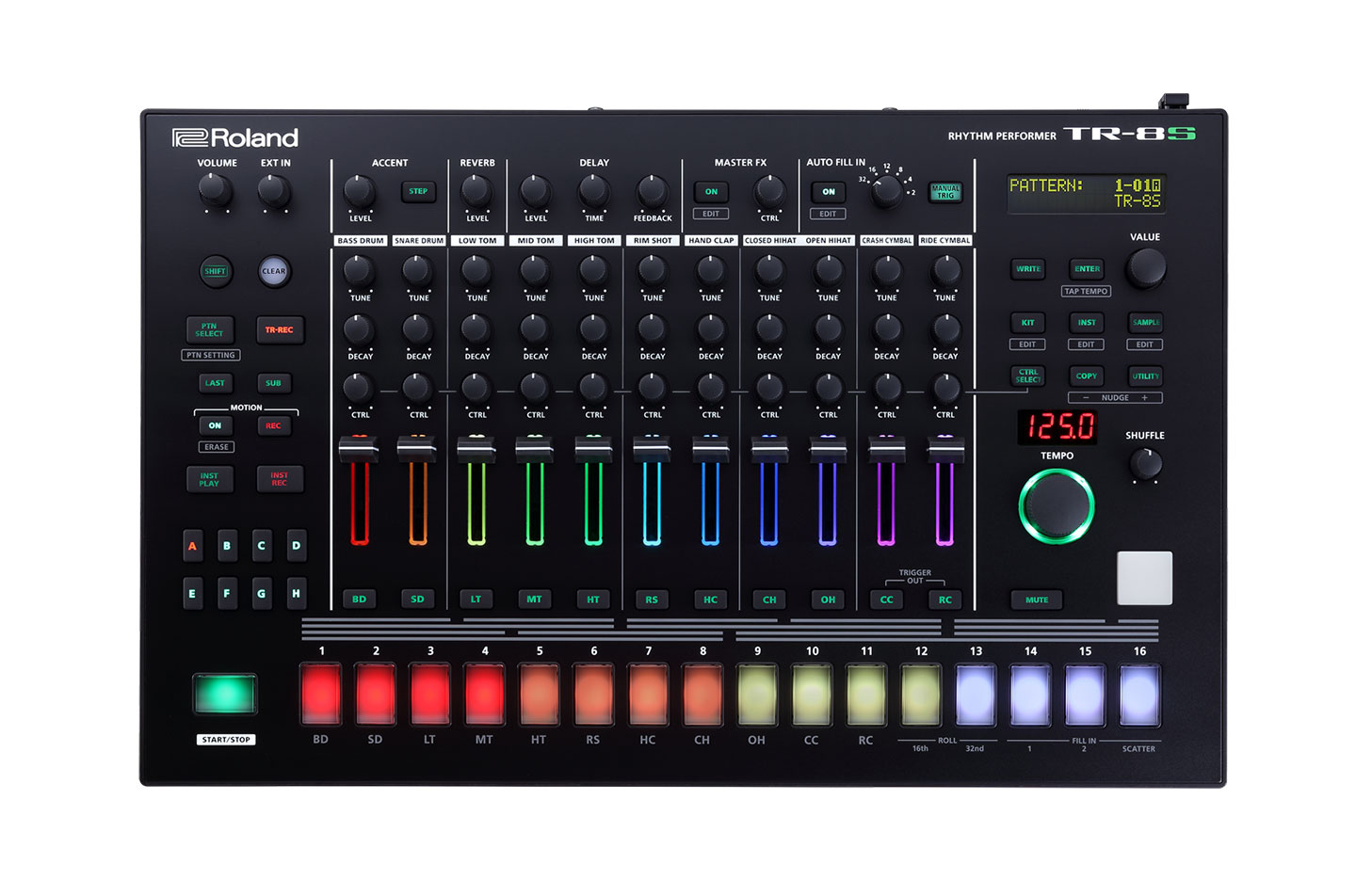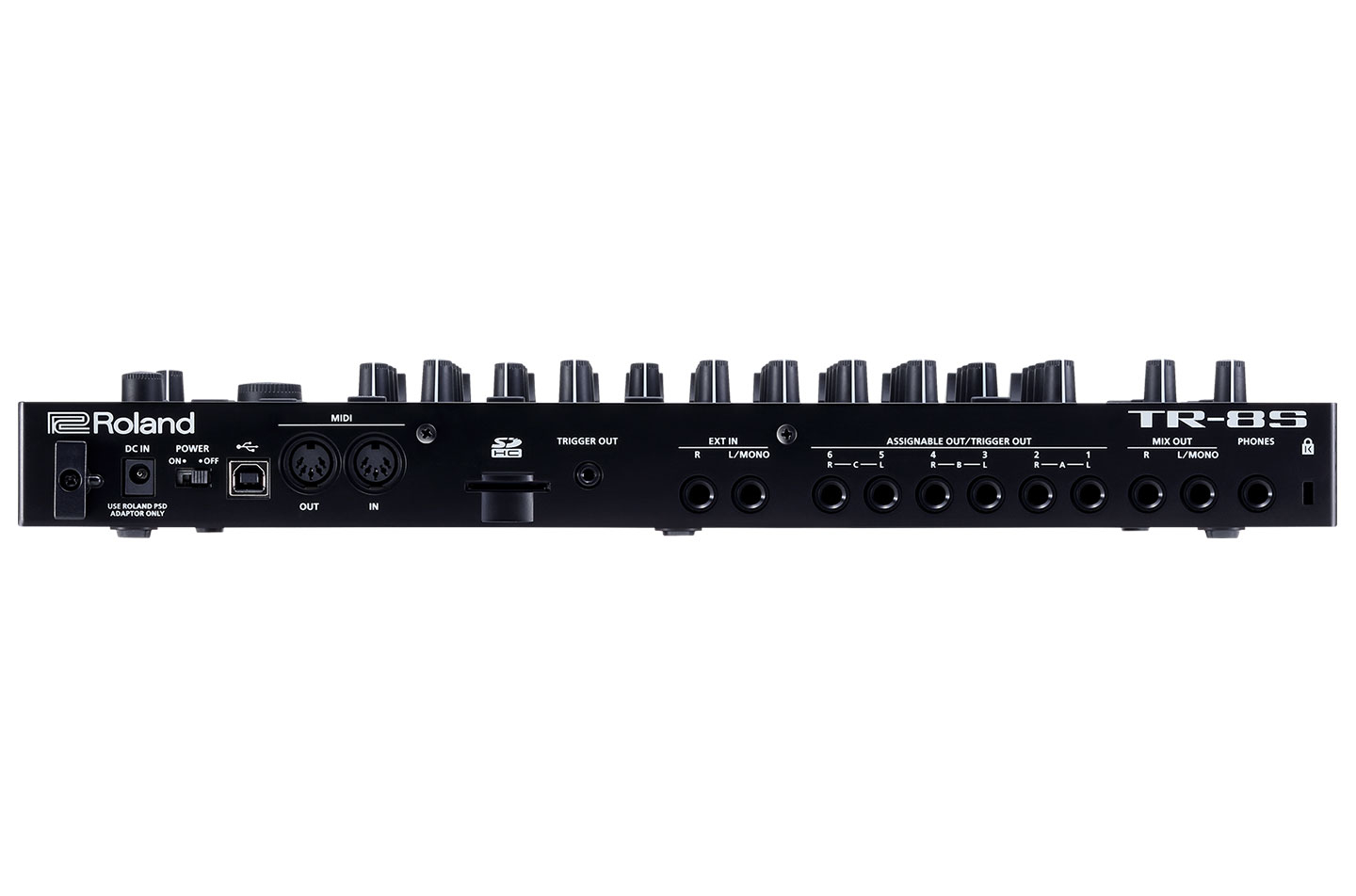- Roland's best new product in years.
- It was only four or five years ago that Roland rediscovered the power of its dance music legacy. As a global corporation, the Japanese juggernaut always had a much broader purview than the house and techno genres its machines shaped in the '80s. Hallowed devices like the TR-808, TB-303 and TR-909 were commercially insignificant, especially compared to Roland's guitar and keyboard-related product lines. It's easy for electronic music specialists to forget that, as far as market volume goes, traditional instruments are very much the cash cow. But dance music developed a nostalgic streak as the 21st century marched on, and the second hand market for those Roland originals became hard to ignore. What's more, the appearance of machines like the Jomox XBase and a plethora of 303 clones made it clear that demand for Roland-inspired designs was far from flagging.
Roland's move finally came with the announcement of the TR-8. It rapidly became a fixture in studios, be they of professional producers or newcomers buying their first piece of gear. Its utility in live performance was immediately obvious, too. Then came the pint-sized Boutique line, DJ controllers and even a move into the Eurorack market—if Roland had been neglectful of its dance music fans in the past, the correction has been expansive to say the least.
Four years later, we get a machine that eclipses these prior efforts. The TR-8S is clearly superior to its predecessor and arguably renders some of the Boutique offerings redundant. Sample support is the big win here. At risk of stating the obvious, it totally opens things up to trigger your own sounds with a TR-style sequencer. While Roland drums are as ubiquitous as a sound can get, it's fair to say that the original TR-8 appealed more to a house or techno producer than, say, someone in drum & bass. With sample support, loading Amens and Apaches into the TR-8S turns it into an interactive break-mangling machine. While it's not a sampler per se, controlling non-Roland sounds with a TR-sequencer rather than a DAW is refreshing. Speed is key. You can programme a pattern, copy it to another pattern slot, punch in variations while the original is playing and then chain them together. Repeat this process a few times and you've enough musical variations to a support a whole track. Like the TR-8, the interface is dead easy to use. Implementing samples just makes this that much more useful.
Sampling aside, the TR-8S comes with many more sounds than the TR-8, which was something of a glorified interface for controlling 808 and 909 hits. Now the 707, 606 and 727 come free of charge. These aren't samples but rather products of Roland's ACB circuit modelling technology. Sound-wise, they're more or less what you'd expect, but on-board effects like transient shaping, compression, bit reduction and overdrive give you scope to nudge them in the right direction. High quality Roland drum sounds are a dime a dozen but the ACB versions stack up well. Besides, there's nothing stopping you from uploading your own favourite Roland samples if you take issue with any of the individual sounds. While the prime attraction is using your own samples, the TR-8S also comes with a host of pre-loaded sounds, many of which are surprisingly useable.
Some have questioned whether it's possible to load stems or backing tracks into the TR-8S with an eye to using it as an all-in-one performance tool. But that's not really what it's built for. Still, you can build fleshed out ideas with the TR-8S alone, especially if you load in samples besides drums, like chord stabs, vocal snippets, bass sounds and so on. If you're looking for extensive sample manipulation, you'd best look at the Elektron Digitakt, but you do have control over essentials like direction and start point. However, it's all about what you put in. With a stimulating combination of samples, I never wished for more extensive control, as it really is all about that sequencer.
Roland has done a fine job of adding greater rhythmic complexity without losing the immediacy that's made the TR-sequencer so influential. Flams, sub-steps, per-step accents, custom and automatic fills, an extra pad for knocking in velocity variations live, pattern chaining, step length variations—used together, you can quickly build psychotically complicated beats with relative ease. To compare again with the Digitakt, the TR-8S can't make chance-based, generative patterns, but you can certainly fake it with the features on board. Importantly, you can achieve these dynamic rhythms without expending much brain power. The sizeable cherry on top is that the newly-added individual outputs can also be used as triggers for controlling external gear. With this in mind, the TR-8S could quite feasibly become the sequencer brain for your studio, especially when you take the dedicated trigger out into account.
Another area where Roland beefed things up is effects. You have the option to affect the master output as well as individual tracks thanks to a new assignable control knob. Most producers have dedicated go-to VSTs for these duties, but there's something to be said for establishing the vibe within the instrument itself, even if the effects aren't as flexible as their software counterparts. The crucial introduction of motion sequencing means you can perform detailed automation lines stretching across multiple patterns, which can also be used for processing external signals via the stereo EXT IN jacks.
The learning curve for all this is about as gentle as it gets. Experienced producers might not care so much about this point, but it's a vital trait of the instrument. Even if you regularly deal with more taxing kit, the sheer ease-of-use and flexibility works wonders for workflow and work rate in the studio. Compared to the TR-8 and the Boutique line, this is a fully-fledged instrument. You'd be hard-pressed to find a drum machine with similar capabilities in this price bracket that's so intuitive.
Ratings:
Cost: 3.9
Versatility: 4.6
Ease of use: 4.8
Sound: 4.2
 Another area where Roland beefed things up is effects. You have the option to affect the master output as well as individual tracks thanks to a new assignable control knob. Most producers have dedicated go-to VSTs for these duties, but there's something to be said for establishing the vibe within the instrument itself, even if the effects aren't as flexible as their software counterparts. The crucial introduction of motion sequencing means you can perform detailed automation lines stretching across multiple patterns, which can also be used for processing external signals via the stereo EXT IN jacks. The learning curve for all this is about as gentle as it gets. Experienced producers might not care so much about this point, but it's a vital trait of the instrument. Even if you regularly deal with more taxing kit, the sheer ease-of-use and flexibility works wonders for workflow and work rate in the studio. Compared to the TR-8 and the Boutique line, this is a fully-fledged instrument. You'd be hard-pressed to find a drum machine with similar capabilities in this price bracket that's so intuitive. Ratings: Cost: 3.9 Versatility: 4.6 Ease of use: 4.8 Sound: 4.2
Another area where Roland beefed things up is effects. You have the option to affect the master output as well as individual tracks thanks to a new assignable control knob. Most producers have dedicated go-to VSTs for these duties, but there's something to be said for establishing the vibe within the instrument itself, even if the effects aren't as flexible as their software counterparts. The crucial introduction of motion sequencing means you can perform detailed automation lines stretching across multiple patterns, which can also be used for processing external signals via the stereo EXT IN jacks. The learning curve for all this is about as gentle as it gets. Experienced producers might not care so much about this point, but it's a vital trait of the instrument. Even if you regularly deal with more taxing kit, the sheer ease-of-use and flexibility works wonders for workflow and work rate in the studio. Compared to the TR-8 and the Boutique line, this is a fully-fledged instrument. You'd be hard-pressed to find a drum machine with similar capabilities in this price bracket that's so intuitive. Ratings: Cost: 3.9 Versatility: 4.6 Ease of use: 4.8 Sound: 4.2